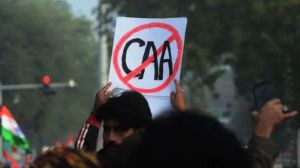Beijing’s Arab Initiative
After a highly focused African initiative that will conclude in a China-Africa summit later this year, Beijing is well poised to repeat the pattern in the Arab world.

After a highly focused African initiative that will conclude in a China-Africa summit later this year, Beijing is well poised to repeat the pattern in the Arab world. At the end of this month 22 foreign ministers from the Arab world will arrive in Beijing for a second round of collective consultations on political and economic cooperation with China. China has good reasons to exult — this is the first time that Arab foreign ministers are gathering in full strength outside the Middle East. Beijing is betting that this initiative will firmly position a rising China as a powerful political player in the Middle East. Co-hosting the summit are the Secretary General of the Arab League Amre Mousa and Sheik Abdullah bin Zayed Al Nahyan from the UAE, whose country holds the rotating presidency of the League.
Oil is naturally at the top of agenda. As China pursues energy security amid soaring oil prices, expect the summit to produce many deals on Chinese investments across the full spectrum of the petroleum industry. China imported 52 million tons of crude oil from Arab countries last year, and trade volume with the Arab world has galloped to nearly $52 billion in 2005.
Oil is not the only thing on China’s mind in the Middle East. It wants power and influence to shape political outcomes in one of the more important regions of the world.
Race for New Ideas
India is falling behind China in Africa and the Arab world not because of a shortage of diplomatic and financial resources. It is the failure to come up with new ideas that constrains Indian diplomacy. India thinks diplomacy in the Middle East is all about voting right in the UN General Assembly. Worse still, both the UPA government and the NDA regime have sought to play domestic politics with the nation’s Arab policy. As a consequence, India’s huge cultural and political advantages over China in the Arab world have been squandered. The Chinese President Hu Jintao, who travels so little, found time to go on a return visit to Riyadh last month, weeks after King Abdullah’s sojourn in Beijing — the first by a Saudi sovereign. The Saudis also sought an accelerated follow up to Abdullah’s visit to India in February by sending their foreign minister Saud al Faisal to New Delhi.
But there is no rushing India’s diplomacy. There’s no word on when the Indian Prime Minister might find time to hop over to the Gulf, less than four hours from Delhi. After announcing with some fanfare that India would negotiate a free trade agreement with the six-nation Gulf Cooperation Council, Delhi continues to drag its feet.
Turkmen Gas
While India debates the ‘‘political correctness’’ of different natural gas pipelines, China is merely interested getting gas from wherever it can and however it can. The CPI(M) has attacked India’s recent decision to join the so-called TAPI pipeline involving Turkmenistan, Afghanistan, Pakistan and India under alleged American pressure. For the Indian left, the Iran pipeline must be ‘‘progressive’’ because Americans oppose it and, by the same logic, the Turkmen pipeline must be unacceptable.
But if you let some facts come in the way, the Americans are in no position to deliver the gas from Turkmenistan. Unlike the Indian left, the Chinese communists know that only the boss-man of Turkmenistan, Sapimurad Niyazov, also known as “Turkmenbashi”, can deliver the gas. Assuming he has any to sell, for the Russians have already tied up most of the supplies at low prices. Without Moscow’s nod, which might necessarily involve offering a big slice of the TAPI deal to the Russian energy companies, gas from Turkmenistan will remain a pipe dream.
That is precisely why Beijing laid out the red carpet for Niyazov last month and got him to sign an agreement that promises — only a promise, mind you — to sell 30 billion cubic metres of gas from 2009 to 2039. In return China has offered to assist Niyazov’s search for oil and natural gas and supply all the raw material needed for the construction of a pipeline from Turkmenistan to China via Central Asia. With Turkmen reserves remaining a dispute and tough price negotiations to be completed, China has a long way to go before it can get gas from Niyazov. Beijing, nevertheless, is knocking on the right door.
American generals in Tibet
A few years ago, when India carried out joint exercises with American troops in Ladakh (which shares a border dispute with China), there was some concern in New Delhi about the potential reaction from Beijing. While Pakistan, which contests Indian sovereignty over Jammu and Kashmir, objected to the exercise, Beijing said nothing in public. China was indeed confident enough to show off Tibet to a group of 19 U.S. Army generals earlier this month. The “People’s Daily” tells us that the American soldiers were surprised by the rapid pace of progress in Tibet.
China-Pak FTA
While Sonia Gandhi opposes India’s free trade agreements, China is all set to clinch such arrangements with our neighbours. A few days ago, Chinese officials completed a third round of talks on an FTA with Pakistan. The first agreements from this talks are likely to be signed by the end of the year. As Pakistan’s economy gathers momentum, trade volumes with China are rising at about the same speed as that of India. Last year Sino-Pak trade grew at nearly 40 per cent to reach $4.25 billion and is now nearly five times larger than the official Indo-Pak trade, which stood at a little less than $1 billion. Last year, Chinese commerce with Bangladesh overtook Delhi’s formal trade with Dhaka. As China races to become the largest trading partner of all the South Asian countries in a few years, the Congress Party’s argument with itself on free trade might reduce Delhi into playing economic second fiddle to Beijing even in the subcontinent.
raja.mohan@expressindia.com



- 01
- 02
- 03
- 04
- 05




























